Integration testing verifies the interaction between integrated components to ensure they work together correctly and identify interface defects early. It is crucial in detecting issues that individual unit tests might miss, improving overall software reliability and performance. Discover more about how integration testing strengthens your development process in the full article.
Table of Comparison
| Aspect | Integration Testing | White-box Testing |
|---|---|---|
| Definition | Testing combined modules for data flow and interface correctness | Testing internal code structure and logic details |
| Focus | Interaction between integrated units | Code coverage, paths, branches, and conditions |
| Testing Level | System integration phase | Unit or module level |
| Test Design Basis | Interface specifications and functional requirements | Source code, algorithms, and control flow |
| Tools | Postman, SoapUI, JUnit (integration) | JUnit, NUnit, Emma, JaCoCo |
| Goal | Identify interface defects and data inconsistencies | Detect missing logic, dead code, and security gaps |
| Performed By | Testers or QA engineers | Developers or testers with code knowledge |
| Visibility | Black-box for integrated components | Transparent testing with code insight |
Introduction to Integration Testing and White-box Testing
Integration testing examines how individual software modules interact and function together as a group, identifying issues in data flow and interface mismatches between components. White-box testing involves analyzing the internal logic and structure of code, focusing on code coverage, statement execution, and branch testing to ensure thorough examination of the software's internal operations. Both testing methods complement each other: integration testing targets combined module behavior, while white-box testing aims at detailed code correctness within modules.
Key Definitions: Integration Testing vs White-box Testing
Integration Testing evaluates the interaction between multiple software modules to identify interface defects and ensure combined functionality. White-box Testing involves examining the internal logic, code structure, and paths of individual components to verify correctness and optimize code coverage. Both testing methods are essential for software quality assurance but target different levels and perspectives within the development lifecycle.
Main Objectives of Each Testing Method
Integration Testing primarily aims to verify the interfaces and interactions between combined modules to ensure they function correctly as a group. White-box Testing focuses on examining the internal logic, code structure, and flow within individual components to identify security vulnerabilities, code errors, and optimize performance. Both testing methods enhance software quality, with Integration Testing emphasizing component collaboration and White-box Testing emphasizing code integrity.
Test Levels and Scope Comparison
Integration testing evaluates the interaction between integrated modules to identify interface defects and ensure combined functionality works as intended, typically positioned between unit and system testing levels. White-box testing focuses on internal code structure, logic, and paths within individual components, emphasizing thorough coverage at the unit testing level. While integration testing addresses data flow and communication across modules, white-box testing targets in-depth validation of a single module's internal operations and control flow.
Approaches and Techniques Used
Integration testing involves combining individual software modules and testing them as a group to validate data flow and interaction between components, typically using top-down, bottom-up, or sandwich approaches. White-box testing examines the internal logic and structure of the code, employing techniques such as statement coverage, branch coverage, path coverage, and code instrumentation to ensure all control paths are tested. While integration testing emphasizes interface accuracy and data communication, white-box testing focuses on internal code validation and logic correctness.
Types of Defects Detected
Integration testing primarily detects interface defects, data flow errors, and communication issues between integrated modules, ensuring that combined components function together correctly. White-box testing uncovers internal coding errors, logic flaws, and security vulnerabilities by examining the program's internal structure and control flow. Both testing types are essential for a comprehensive defect detection strategy, targeting different layers of software quality assurance.
Tools Commonly Used in Both Testing Types
Integration testing and white-box testing both utilize tools such as JUnit, TestNG, and Selenium to automate test execution and verify code behavior. Common frameworks like Mockito support mocking dependencies, enhancing test isolation in both testing types. Code coverage tools including JaCoCo and Cobertura help measure testing completeness by analyzing tested code paths across integration and white-box tests.
Advantages and Limitations
Integration Testing enhances system reliability by verifying interactions between combined modules, facilitating early detection of interface defects and data flow issues; however, it may overlook internal code logic errors since it focuses on module integration rather than individual unit details. White-box Testing offers comprehensive code coverage, enabling identification of hidden software bugs through detailed path and condition analysis within the source code, but it requires extensive programmer knowledge and can be time-consuming for large codebases. Both testing methods complement each other by addressing different testing scopes, balancing thorough internal validation with effective inter-module communication checks.
Best Practices for Implementation
Integration testing best practices emphasize testing interfaces and data flow between modules to detect interface defects early, using realistic test scenarios and incremental integration approaches like top-down or bottom-up. White-box testing requires thorough knowledge of the internal logic, with test cases designed to cover all code paths, branches, and conditions, often utilizing tools for code coverage analysis. Effective implementation involves combining both techniques to ensure comprehensive verification of system functionality and internal code behavior, enhancing overall software quality.
Choosing the Right Testing Approach
Choosing the right testing approach depends on project goals and software maturity; integration testing verifies the interaction between modules, ensuring combined components function seamlessly, while white-box testing examines internal code structure for thorough coverage and defect identification. Integration testing is ideal for detecting interface issues and validating data flow across modules, whereas white-box testing excels in uncovering logical errors and optimizing code paths. Balancing both approaches enhances software quality by addressing different aspects of functionality and reliability.
Integration Testing Infographic

 libterm.com
libterm.com